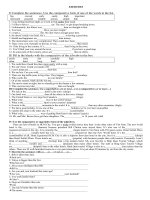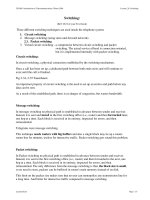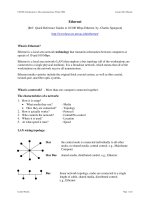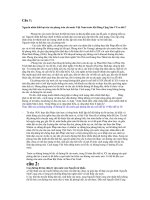Tài liệu Atmosphere of Earth pdf
Bạn đang xem bản rút gọn của tài liệu. Xem và tải ngay bản đầy đủ của tài liệu tại đây (7.76 MB, 81 trang )
EARTH’S
OUTER
ATMOSPHEREEARTH
’
S SPHERES
TWENTY-FIRST CENTURY BOOKS
•
MINNEAPOLIS
Text copyright © 2007 by Gregory L. Vogt
All rights reserved. International copyright secured. No part of this book may be
reproduced, stored in a retrieval system, or transmitted in any form or by any
means—electronic, mechanical, photocopying, recording, or otherwise—without
the prior written permission of Lerner Publications Company, except for the
inclusion of brief quotations in an acknowledged review.
Twenty-First Century Books
A division of Lerner Publishing Group
241 First Avenue North
Minneapolis, MN 55401 U.S.A.
Website address: www.lernerbooks.com
Library of Congress Cataloging-in-Publication Data
Vogt, Gregory.
Earth’s outer atmosphere : bordering space / by Gregory L. Vogt.
p. cm. — (Earth’s spheres)
Includes bibliographical references and index.
ISBN-13: 978–0–7613–2842–1 (lib. bdg. : alk. paper)
ISBN-10: 0–7613–2842–4 (lib. bdg. : alk. paper)
1. Atmosphere, Upper—Popular works. 2. Atmosphere—Popular works.
I. Title.
QC879.V64 2007
551.51'4—dc22 2006019426
Manufactured in the United States of America
1 2 3 4 5 6 – DP – 12 11 10 09 08 07
eISBN-13: 978-0-8225-8780-4
CONTENTS
INTRODUCTION . . . . . . . . . . . . . . . . . . . . . . . . .6
SWIRLING LIGHTS
CHAPTER 1 . . . . . . . . . . . . . . . . . . . . . . . . . . .12
THE EDGE OF SPACE
CHAPTER 2 . . . . . . . . . . . . . . . . . . . . . . . . . . .30
THE SUN HAS
ITS MOMENTS
CHAPTER 3 . . . . . . . . . . . . . . . . . . . . . . . . . . .46
DEEP DOWN BELOW
CHAPTER 4 . . . . . . . . . . . . . . . . . . . . . . . . . . .61
SHIELDS UP!
CONCLUSION . . . . . . . . . . . . . . . . . . . . . . . . . .69
POKER FLAT, ALASKA
GLOSSARY . . . . . . . . . . . . . . . . . . . . . . . . . . . .74
BIBLIOGRAPHY . . . . . . . . . . . . . . . . . . . . . . .76
FOR FURTHER INFORMATION . . . . . . . . . . . . . . .77
INDEX . . . . . . . . . . . . . . . . . . . . . . . . . . . . . .78
6
The air in the
crowded flight deck was
filled with the high-pitched
whine of cooling fans. Air drafts
bounced from wall to ceiling and circu-
lated among thousands of switches and controls.
Green letters and numbers flickered on the monitors
spanning the panels toward the nose of the space
shuttle Discovery.
The commander and pilot of the STS-39 mission were
busy monitoring systems and reviewing orbital maneu-
vers they would have to perform when they returned to
Earth. Oceans, islands, mountains, forests, and deserts
were all flashing by at a speed of 5 miles (8 kilome-
ters) per second. Earth’s Southern Hemisphere was
160 miles (260 km) beneath them.
SWIRLING
LIGHTS
INTRODUCTION
Toward the back of the flight deck, an astronaut was
staring out the two windows facing the payload bay.
Through these windows, the crew can operate payloads
mounted in the bay and manipulate the 50-foot-long (15 me-
ters) robot arm. But it was not the arm that had captured
the attention of the astronaut. Discovery had passed into
the dark nightside of Earth, but the sky was still aglow.
Above most of Earth’s atmosphere and stretched out in
front of and below Discovery’s orbit were swirls and rays of
intense greenish light hanging against the nearly pitch-
black background. These
ghostly displays are called auro-
ras, or northern and southern
lights, depending upon which
7
The crew of the Space Shuttle
STS-39 mission took this picture of
the aurora australis, or southern
lights, while orbiting above Earth’s
Southern Hemisphere.
hemisphere of Earth you are in when you see them. The
light show slowly moved and danced, dimmed and flared.
It was an astounding ghostlike display. The astronauts
soon powered up a camera and took photographs.
In the foreground of the photos was Discovery’s verti-
cal stabilizer, or tail fin. Discovery was tilted to its port
side so that its left wingtip was pointed down at Earth
and the stabilizer was parallel to Earth’s surface. A white
glow silhouetted the rounded orbital maneuvering sys-
tem, rocket engine pods flanking the sides of the stabi-
lizer. The glow came from faint traces of oxygen gas that
collided with the pods as Discovery streaked across the
sky. The impacts energized the widely spaced oxygen
atoms and caused them to glow momentarily before they
returned to their normal quiet state.
Other crew members took turns at the windows to
enjoy the aurora light show. The display soon faded be-
cause Discovery passed from the nightside to the dayside
of Earth, where sunlight overpowered the faint colors. It
would be another forty-five minutes before they could
round Earth to the nightside and see the lights again.
For many astronauts, the best part of spaceflight is
looking at Earth. Things Earth dwellers take for granted,
such as sunsets and sunrises and land and water, take on
a new beauty when seen from 160 miles (260 km) away.
Earth is a magnificent planet of rock, metal, water, air,
and living things. Yet Earth is a relatively small planet
when compared to some of the other planets in our solar
8
EARTH’S OUTER ATMOSPHERE
system, such
as Jupiter or
Saturn. Jupiter
is eleven times
as wide as
Earth. Saturn’s
outermost rings could easily surround Earth and the
Moon in its orbit. What sets Earth apart from the other
planets is its incredible structure and diversity. Earth is a
planet of major and minor spheres, some visible and
some invisible.
Deep inside Earth where no one can see, Earth has a
spherical core. The core is two-layered, with solid iron
and nickel metal at its center, surrounded by a thick
molten layer of the same two metals. Above the core is
a spherical layer called the mantle. It is made of super-
hot rock that slowly deforms and rises and falls with
heat currents.
Covering the mantle is a relatively thin, hard, rocky
layer called the lithosphere. The lithosphere is the sur-
face, or crust, of Earth that we walk on. It is made up of
all the continents with their mountains, valleys, and
SWIRLING LIGHTS
9
A full-hemisphere view of
Earth taken in 1997. This
image was created by
using data from three
satellites and shows a
hurricane approaching
Baja California in Mexico.
plains, as well as the ocean basins.
Water is in the lithosphere’s small de-
pressions and wide basins and within
the spaces between mineral grains in
the soil and sub-surface rock. Water
surrounds approximately three-
quarters of the surface of the crust with great oceans. All
the water on Earth is called the hydrosphere.
Enveloping the water and solid parts of Earth’s sur-
face is another relatively thin sphere comprised of gas.
This is the atmosphere. All the events we call weather
10
THE EARTH
’
S LAYERS
Earth is made up almost
entirely of rock and metal.
Its air, water, and life zones
(atmosphere, hydrosphere,
and biosphere) are far too
thin to appear in this cross
section diagram showing
Earth’s inner layers.
take place here. Another sphere, the thinnest of all, in-
termingles with Earth’s rock, water, and air. An esti-
mated 30 million different kinds of living things exist.
This is the biosphere.
Earth’s last major sphere is the transition zone be-
tween the planet and outer space. This sphere starts at
the upper levels of the atmosphere, where the remaining
atoms of gas are so widely spaced that no life can exist. It
then stretches out thousands of miles from Earth. This
sphere is the hardest to describe because its thickness
can change. Furthermore, it appears empty, but it actually
contains small amounts of gas. It is crisscrossed by radia-
tion of all kinds and by intense magnetic fields. Here the
ghostly light seen by Discovery’s crew appeared. It’s here
Earth first interacts with the Sun’s energy. This is Earth’s
outer atmosphere, where planet Earth meets outer space.
You are about to learn its story.
The gases in
Earth
’
s outer
atmosphere are primarily
hydrogen and helium at
extremely low densities.
1122
When astronauts
rocket skyward, we say
they are traveling to outer
space. That is not entirely accu-
rate if all they do is climb above Earth’s
surface and begin orbiting the planet. Space shuttle
crews usually orbit Earth at altitudes of 100 to 300 miles
(160 to 480 km). That sounds pretty high as long as you
don’t compare it to the size of Earth below.
Take a piece of twine and tightly wrap a circle around
a world globe. If Earth were the size of that globe, a tiny
space shuttle would orbit no higher above the globe
than the outer edge of the twine! Since Earth’s atmo-
sphere reaches out toward space 10,000 miles (16,000
km) or more, space shuttles actually orbit Earth
within its atmosphere.
THE EDGE
OF
SPACE
CHAPTER 1
To actually reach outer space,
an astronaut has to travel beyond
the atmosphere to the region be-
tween the planets. Outer space is
the void between the rocky and
gaseous planets and the superhot stars. Except for sub-
atomic particles such as electrons and protons, ions
(atoms that have an electric charge), and rocky or icy dust
fragments, outer space is almost completely empty. That’s
why it’s called space.
The place we usually think of as space, where astronauts
orbit Earth, is really just a continuation of Earth’s atmos-
phere. It is a vast zone surrounding the planet. It consists of
extremely thin gases and magnetic field lines that pass from
Earth’s interior out into deep space beyond the Moon.
1133
As the Sun sets over the
Sahara Desert, the thinning of
Earth’s atmosphere is seen in
this picture taken from space
by the crew of the Space
Shuttle STS-101 mission.
The material present in Earth’s outer atmosphere is
about as close to nothing as you can get. The amount of
matter there is difficult to guess. One estimate states
that if you took all the air molecules above 1,000 miles
(1,600 km) and clumped them together, they would
equal the number of molecules found at sea level in a
single cube of air slightly less than 0.5 inch (1 cubic cen-
timeter) on a side. Still, that’s a lot of air molecules—
about 20 billion billion!
INNER AND OUTER
LIMITS?
Where does the outer atmosphere begin, and where does
it end? There are no easy answers to these questions.
The outer atmosphere may begin as low as 200 miles (320
km) or as high as 470 miles (750 km). It may end at 1,000
miles (1,600 km), 10,000 miles (16,000 km), or higher.
There are many reasons why the numbers are uncertain.
One reason for not being able to come up with definite
limits for the outer atmosphere has to do with the scien-
tists who study it. There are many different kinds of sci-
ence, and scientists don’t always agree. A scientist’s job is
to try to understand the meaning behind observations and
data. Depending on what a particular scientist is looking
for, that scientist may define the limits of the outer atmos-
phere differently than another scientist would. This is
something like looking at the world with sunglasses on. If
14
EARTH’S OUTER ATMOSPHERE
you put on rose-colored lenses, everything you see will
have a rosy tint to it. If you wear brown or blue lenses, the
world will take on brown or blue tones. Something similar
happens with scientists. The tools they use are like the
sunglasses. They see and record different things.
Different kinds of scientists have devised different sys-
tems for dividing up the atmosphere, based upon their in-
terests. The layers they identify have their own special
sets of characteristics. Meteorologists (scientists who
study weather) divide the atmosphere into layers by
physical characteristics such as temperature and pressure
and types of weather. Physicists (scientists who study
forces and energy) focus on the electrical properties of the
atmosphere. Physicists have discovered that the higher
you go, the more electrically charged the atmosphere be-
comes. Atmospheric chemists look at the chemical reac-
tions taking place. Rocket scientists are concerned with
the density of the atmosphere so that they know where
they can orbit their spacecraft.
For our study of the outer atmosphere, we will adopt
the most commonly used system, which was created by
meteorologists. Keep in mind that much overlap exists
among diverse systems, but various books and websites
may use different numbers. The different systems do not
necessarily mean disagreement among scientists. They
are just different perspectives.
In this system created by meteorologists, the lowest
atmospheric layer is called the troposphere. Here most of
THE EDGE OF SPACE
15
Earth’s air and water vapor are found and most of Earth’s
weather takes place. Above the troposphere, starting at
an altitude of 7 miles (11 km), is the stratosphere. The
stratosphere is the calm layer of very cold air where long-
distance jet airliners fly. The stratosphere stretches up-
ward to about 30 miles (50 km).
The layer called the mesosphere is above the strato-
sphere. The mesosphere is where many chemical reac-
tions take place. The upper edge of the mesosphere is
about 50 miles (80 km) above Earth’s surface.
16
EARTH’S OUTER ATMOSPHERE
THE LAYERS OF THE ATMOSPHERE
I
n your research, you are likely to come across the term ionosphere.
This is one of those overlapping systems that physicists and other at-
mospheric scientists identify. The ionosphere refers to a wide region of the
upper atmosphere. It stretches from within the mesosphere into outer
space. The ionosphere is characterized by the presence of ions.
In the thicker reaches of the mesosphere and thermosphere and well
up into the very thin outer atmosphere, individual gas atoms, such as oxy-
gen, nitrogen, hydrogen, and helium, are exposed to intense solar radia-
tion. This radiation creates atoms with a positive charge by knocking
outer electrons out of their orbits around the nucleus. Radio waves from
transmitters on Earth reflect off these scattered electrons like light reflects
off a mirror. This enables radio signals to bounce around Earth, rather
than simply escaping into space.
The ionosphere is not a perfect “mirror.” At the wrong angle, radio
waves are absorbed or pass through it. Also, bubblelike holes sometimes
form in the ionosphere and break up radio waves. This can be a problem
when radio stations on Earth try to communicate with a satellite or space-
craft. This can also affect the “lock” of GPS (global positioning system)
navigation units. Without the lock, GPS users are unable to determine
their locations on Earth.
Space weather changes have a big effect on the ionosphere.
Scientists are actively studying these effects. They have divided the iono-
sphere into three main layers. The lowest is called the D region. Then
going upward are the E and F regions. The problematic “bubbles” appear
in the F region.
••••••••••••••••••••••••••••••••••••••••••••••••••••••••••••••••••••••••••••
T
HE IONOSPHERE
About 99 percent of all Earth’s atmosphere lies below
this edge. Once you go above the mesosphere, you are of-
ficially an astronaut and earn your astronaut wings.
In this system of layers, next is the thermosphere.
Except for a few Apollo missions to the Moon, no astro-
nauts have gone higher than the thermosphere. Up to this
point, the temperature of the atmosphere has generally
fallen with increases in altitude. The thermosphere gets
its name from a reversal of the temperatures. Within this
zone, the temperature of the few gas atoms and mole-
cules present in the thermosphere rises as high as
3,100°F (1,700°C). Yet, if you could stick your bare hand
into the thermosphere, you wouldn’t notice the high tem-
perature because the air is way too thin to feel.
Finally, there is the outer atmosphere, sometimes re-
ferred to as the exosphere. Although it stretches for thou-
sands of miles above Earth, it contains the fewest gas
atoms of any atmospheric layer. You will notice that we
haven’t settled on a number for how high we have to go to
reach the outer atmosphere or how far out it extends. Only
approximate measurements exist, for a number of reasons.
The primary reason is that the thickness of Earth’s
lower atmospheric layers is not constant. These air lay-
ers change in thickness all the time. They expand during
the day and expand or contract with the seasons and
with activity cycles of the Sun. They even change in
thickness according to the positions of the Moon and the
Sun in the sky. This last effect has to do with gravity.
18
EARTH’S OUTER ATMOSPHERE
••••••••••••••••••••••••••••••••••••••••••••••••••••••••••••••••••••••••••••
A
toms are the smallest pieces of a chemical element, such as oxygen
or gold, that have all the properties of the element. Break them down
further and they are no longer the same element. Atoms are made up of
three types of smaller particles. Protons and neutrons are found in the
center of atoms in a cluster called the nucleus. Protons have a positive
charge, and neutrons have no charge. Electrons orbit around the nucleus
and have a negative charge. The number of protons and the number of
electrons in an atom are equal. The positive and negative charges cancel
one another out. When exposed to powerful energy sources, atoms can
gain or lose electrons, causing them to become ions. With enough energy,
atoms can be broken apart, freeing protons and electrons.
A
TOMS AND IONS
PARTS OF AN ATOM
This is a diagram of the element helium. It has two
positive protons in its nucleus that are balanced by two
negative electrons orbiting its nucleus. It also has two
neutrons in its nucleus.
It is similar to ocean tides, where water levels rise and
fall around the world depending upon the position of the
Moon and the Sun. With the expansion and contraction
of the lower atmospheric layers, the outer atmosphere is
pushed outward or drawn back.
The daily changes in the thickness of the lower atmo-
spheric layers primarily occur because of heating cycles.
The atmosphere is heated on the dayside of Earth. It
cools off on the nightside. Temperature has a major effect
on the motion of air molecules. You can see this for your-
self with a simple experiment. Take an empty 2-liter (68-
ounce) plastic soft-drink bottle and place it in a freezer.
The bottle starts out with warm air inside, but then the
freezer chills the air. In a couple minutes, take out the
bottle and see what happened to it. Observe the bottle as
it warms up again to room temperature.
Your observations of the bottle will help you to under-
stand why the thickness of atmosphere layers changes
between day and night. Decreasing temperature causes
atoms and molecules in the bottle to move more slowly.
This changes the amount of force the molecules exert
when colliding with the inside walls of the bottle (slower
speeds exert less force, or pressure). With less force in-
side due to the low temperatures of the freezer, the out-
side air squishes the bottle. When the inside molecules
become warm again, their pressure increases and the bot-
tle expands back to its original size.
On the dayside of Earth, increases in temperature
20
EARTH’S OUTER ATMOSPHERE
cause air molecules to move faster and bump against one
another with greater force. The increased force causes
the atmospheric layers to balloon outward against Earth’s
gravity. When the temperature falls during the night, the
motions of the atoms and molecules slow. Less force
pushes them apart, so gravity pulls the atmosphere closer
to Earth’s surface.
Seasonal changes also affect the air temperature. When
it is summer in one hemisphere, it’s winter in the other. The
air over the summer hemisphere is warmer and it expands.
The air over the winter hemisphere is cooler and contracts.
Still another temperature-related factor is Earth’s dis-
tance from the Sun. Earth’s
orbit is not a perfect circle. The
distance varies about 3 million
miles (5 million km). Earth is
21
EARTH
’
S ORBIT
Earth’s distance from the Sun varies
about 3 million miles (5 million
kilometers). This distance change
only accounts for slight increases or
decreases in the energy Earth’s
atmosphere receives from the Sun.
actually closer to the Sun during the Northern Hemisphere
winter than it is during the summer. The change in dis-
tance slightly increases or decreases the heat energy
Earth’s atmosphere receives from the Sun. The tempera-
ture changes, expands, and contracts the atmosphere.
The factors that can have the greatest and most rapid
effect on atmospheric layer thickness are changes within
the Sun. Across tens of millions of miles (km) of outer
space, solar activity (storms and explosions on the Sun)
blasts out billions of tons of ions. These ions flow in mil-
lion-miles (km)-per-hour streams out into the solar sys-
tem. Some of those streams slam into Earth’s outer
atmosphere.
Solar activity affects Earth’s atmosphere in a variety of
ways. The big bursts of energy cause extra heating of the
atmosphere, altering its thickness. They also cause the at-
mosphere to glow. The processes at work inside the Sun
22
An extreme ultraviolet
imaging telescope took
this image of an
explosion on the Sun in
1999. The hottest areas
on the image appear
almost white, while the
darker red areas indicate
cooler temperatures.
Explosions on the Sun
send streams of ions into
the Earth’s outer
atmosphere.
lead to the explosive ejection of particles throughout the
solar system. Scientists call this space weather.
Because the thickness of the atmospheric layers
changes so much, we have to pick approximate numbers
for where the outer atmosphere begins and where it
ends. Its lower edge (the top of the thermosphere) begins
approximately 375 miles (600 km) above Earth’s surface.
The outer limit lies anywhere from 1,000 to 10,000 miles
(1,600 to 16,000 km) above Earth. This is not a very pre-
cise measurement. It is like telling someone that your
house lies somewhere between Alaska and Argentina.
The main reason for the distance range is that it is im-
possible to be sure just where Earth’s atmosphere ends at
any given time. As air thins out, it becomes harder and
harder to detect. At some point, it is gone and you are in
outer space. Even if you could locate the top of the atmo-
sphere precisely, its edge will be different tomorrow. A
range of 1,000 to 10,000 miles (1,600 to 16,000 km) is
about as precise as it gets.
WHAT IS THE OUTER
ATMOSPHERE LIKE?
Except for true outer space, the outer atmosphere is about
as close to nothing as possible. It is the transition zone be-
tween air and space. It is comprised of atoms and molecules
of gas that are widely spaced. These particles become more
and more widely spaced farther away from Earth.
THE EDGE OF SPACE
23
The spacing of the atoms and molecules is due to
gravity. Air atoms and molecules have mass. The force of
gravity acting on their mass gives them weight. The
lower you go in the atmosphere, the greater the weight
becomes because all the atoms and molecules are piled
on top of one another. As a result, the atoms and mole-
cules are pushed together so that very little space is be-
tween them. At sea level, the particles are so close
together that they can only move about 4 millionths of an
inch (0.00001 cm) before banging into one another. They
collide about five billion times every second. This
amounts to an air pressure of 14.7 pounds per square inch
(101 kilopascals).
At the top of the pile, however, there is very little
weight. One reason is simply that you are at the top. Pile
up a stack of books on a table. Which is easier to lift, the
book at the top of the stack or the book at the bottom of
the stack?
Another reason there is very little weight is that the
force of Earth’s gravity decreases the higher you go. In
the typical orbital range of the space shuttle, gravity di-
minishes to about 92 percent of the gravity at Earth’s sur-
face. At 1,000 miles (1,600 km), gravitational force
diminishes to about 64 percent of surface gravity. This
permits atoms and molecules to be widely spaced. Outer
atmosphere atoms and molecules are so widely spaced
that they may travel 1,600 miles (2,600 km) in twenty
minutes before hitting another atom or molecule.
24
EARTH’S OUTER ATMOSPHERE









